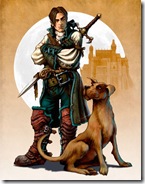
Normally in a game everything’s mapped out for you along the way, and you learn about the character that someone else created. Not so in Fable II, which has given me the only example I can remember of learning about a character that I created.
In dozens of interactions in the Fable II world you have a choice of how to react, generally in cardinal terms of good or evil: you can kill bandits to protect the village or join up with them to pillage in numbers. You can marry, settle down and have kids, or get drunk, sleep with prostitutes and catch an STD.
It’s telling that Microsoft is including a coin in the Fable III collector’s edition to help you make decisions on whether to be good or evil. It’s not always that clear cut, though.
My character, James, is generally well-behaved in public: he takes jobs, rarely belches and tries his best not to ram into people, though sometimes in a hurry it’s unavoidable. In private, however, it’s a different matter: those who accept his proposal often find themselves taken to a secluded corner and killed. He is a textbook Coronation Street killer, even down to the leather gloves. It’s not that accurate a portrayal of me, truth be told.
What I learnt about James, however, is that he’s not a character driven maniacal by greed or a bubbling bloodlust. He doesn’t just make it up as he goes along either: he knows why he does the things he does, and now so do I.
Taken into the Spire and forced to work as a slave, James was offered the opportunity to cut short his suffering by obeying the evil Commandant. Wearing a collar of obedience that drained his experience every time he failed to follow orders, the straightforward “evil” option would be to accept every order and proceed further down the path of darkness. Countless men and women have already died by James’s blade: why not a few more?
And yet he didn’t take the evil option: he gave food to the starving, refused to kill an innocent man and attacked the Commandant, despite the physical pain and loss of experience he’d spent the best part of his life gathering.
The strangeness of this isn’t lost on me: why would James kill his fiancee in Albion yet refuse to hurt a slave in the Spire? The reason, I learnt, is that James is about defiance: refusing to do what’s expected, rather than following a certain path of good or evil.
This oppositional nature isn’t easily crafted in a game – my alpha male Commander Shephard in Mass Effect 2 is often charming his way into the pants of any living creature in the universe whilst simultaneously being Mr Gung-Ho with his squad – so the subtler aspects of Fable II’s system are all the more impressive.
Fable is notorious amongst gamers for failing to deliver on many of its lofty promises – yes, trees that grow, I mean you – but by giving me a real insight into my own character it created something more important to Peter Molyneux than all the money and promises in the world: it gave me a memorable character I created all by myself. For that, it’s only right I say “thank you”.
 My name is James Newton, and this is my website - a collection of my writings about
videogames, music and all my other thoughts.
My name is James Newton, and this is my website - a collection of my writings about
videogames, music and all my other thoughts.